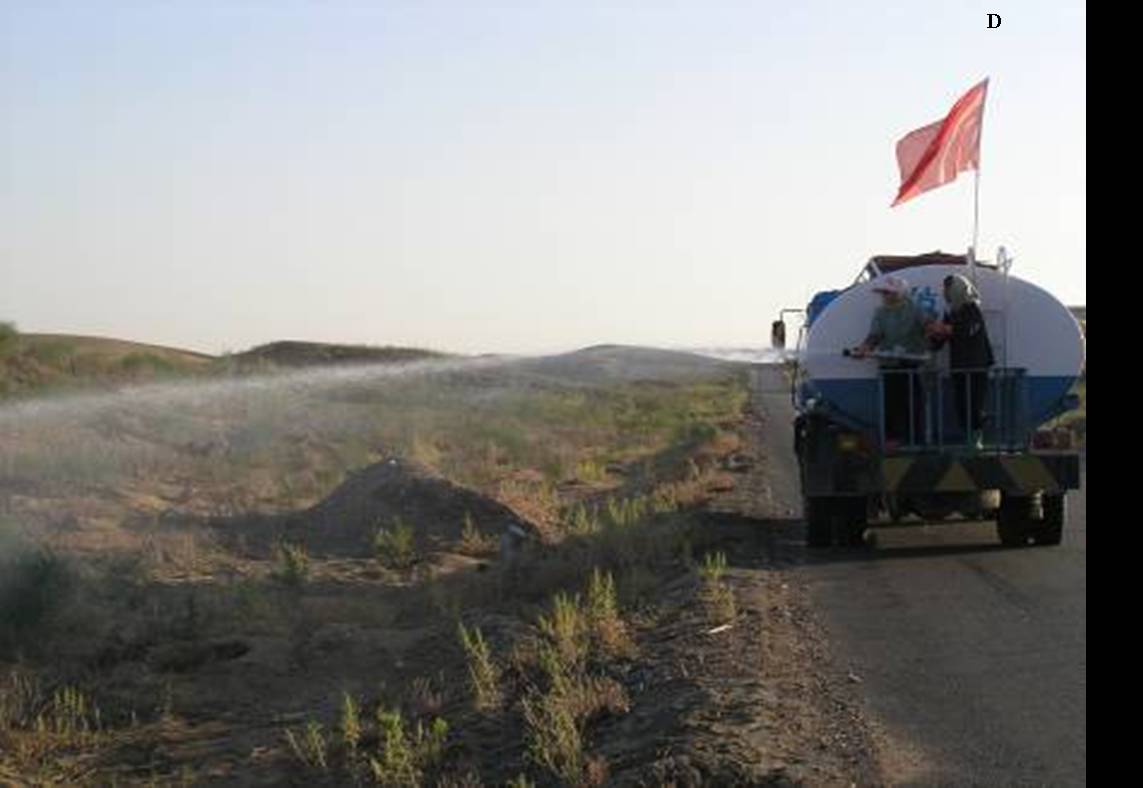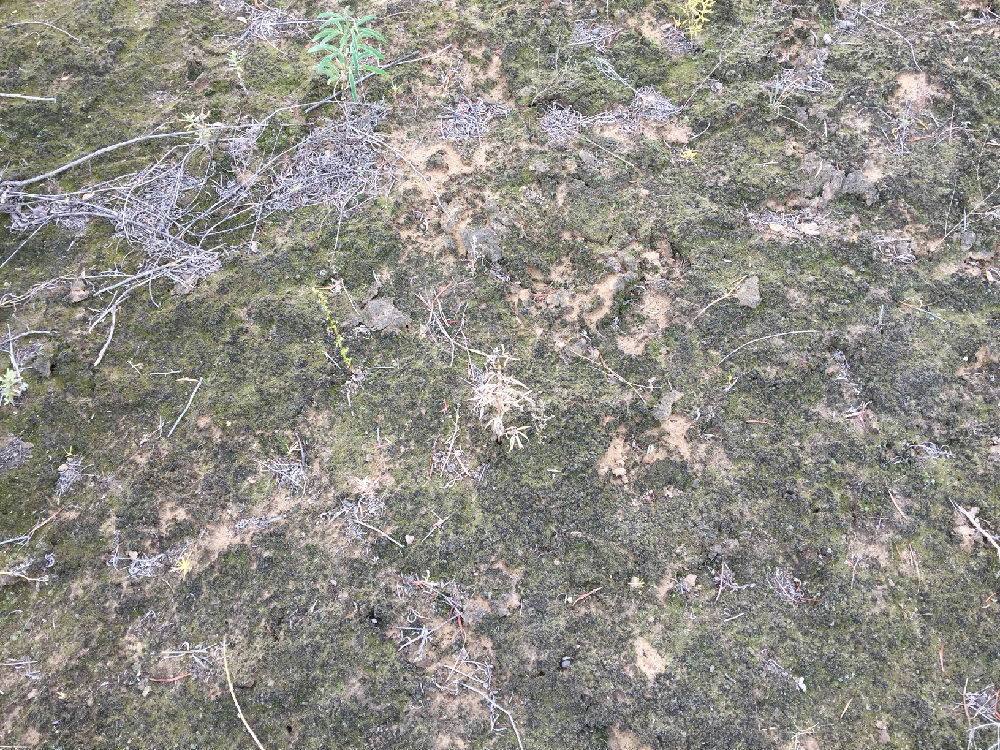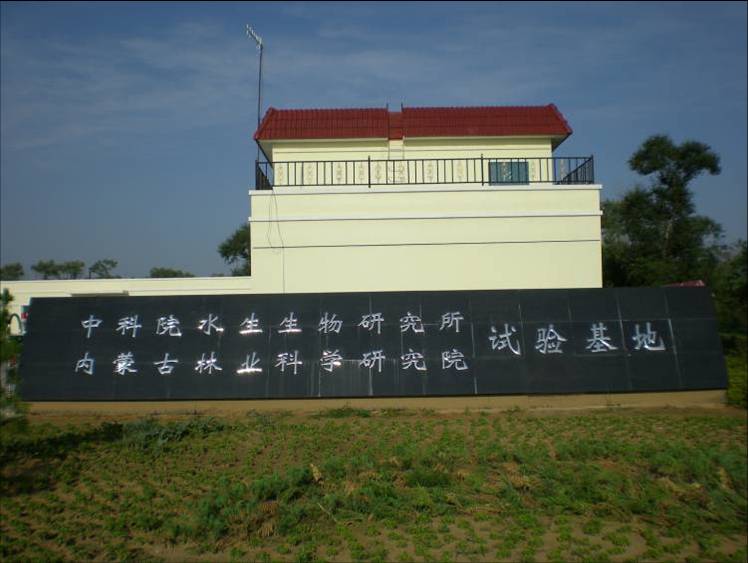博文
中国科学院水生生物研究所荒漠藻及生物土壤结皮基础与应用研究
|
中国科学院水生生物研究所地处“百湖之城”的武汉市。长江与汉江在武汉市交汇后向东流去,将城市切割为武昌、汉口、汉阳三个部分,三镇靠众多的桥梁和隧道联系在一起。昨天(2017年9月12日)武汉市政府宣布将在2018年1月1日取消桥隧ETC收费,届时武汉市将实现真正意义上的“统一”,天堑变通途。
扯远了。作为拥有长江、汉水,以及以中国最大城中湖东湖、汤逊湖为代表的上百个湖泊的武汉市并不缺水,但为什么有一群来自于中科院水生所的学者们却将荒漠藻类作为研究对象呢?每当跟非小同行甚至领导说起此事,总会引来诧异的目光。“藻类不是水里的吗?你们去荒漠里干嘛?”。实际上藻类不仅仅生活在海洋、湖泊、河流、水库、池塘等水体中,它们其实是无处不在的,诸如冰雪层、石头表面甚至石内、土壤、植物体表面甚至组织内。它们还可以与真菌、植物、动物等共生。因此,作为藻类学研究者,研究荒漠里的藻类并不奇怪。
中国科学院水生生物研究所对荒漠藻的研究首先从其区系分布调查开始,逐渐扩展到生理学、生态学和应用技术研究方面,历经几十年,取得了系列成果。我写了下面一个小文,力图使大家对水生所在荒漠藻方面的研究成果有更全面的了解。
----------------------------------------------
中国科学院水生生物研究所荒漠藻及生物土壤结皮基础与应用研究
Desert algae and Biological soil crusts: basic and applied researches in Institute of Hydrobiology, CAS
李敦海
中国科学院水生生物研究所,武汉,430072
荒漠藻是依据分布地域和生境而定义的生态学概念,一般指生长在干旱、半干旱地区的土壤藻,广义上它既包括荒漠土生藻,也包括荒漠石生藻,狭义上仅指荒漠土生藻(刘永定等,2013)。中国科学院水生生物研究所对土壤藻和荒漠藻类的生态学和生理学系统性地开展研究始于1980年代,对农田土壤藻类的种类组成、分布、生理生态学及其与土壤肥力的关系(刘永定和黎尚豪,1988;Liu et al., 1989; 刘永定和黎尚豪,1993;刘永定等,1999),以及干旱地区的土壤藻群落结构及其时空分布进行了研究(洪英等,1992;胡春香等,1999;胡春香等,2000b;胡春香等,2003d)。
从1990年代末到2000年代初,荒漠藻中几种优势种类的分离、纯化和规模化培养以及接种到流沙表面可形成人工诱导的生物土壤结皮的成功,使得研究生物土壤结皮的形成机理成为热点并得以深入。通过对荒漠生物土壤结皮中土壤藻类种类组成开展研究,揭示土壤藻类是生物结皮形成的先锋生物,其中丝状蓝藻通过藻丝缠绕、胶结土壤颗粒及其他微生物而形成有机和无机层(Hu et al, 2002a)。发现藻类在生物土壤结皮中呈精细“层片”分布的规律和发育过程(胡春香等, 2000a; Hu et al, 2003a)及垂直分布规律(胡春香与刘永定, 2003a)。阐明了藻结皮向地衣结皮和苔藓结皮进行原初演替的规律和调控机制(Hu et al, 2003b),对生物土壤结皮的生理生态学研究发现,结皮的演替呈现区域异质性,Na、K和沙粒含量和初期的生物量积累是影响地衣演替的关键因素,而生物土壤结皮的保水能力则影响着苔藓的萌发(Lan et al., 2015)。发现降雨量和土壤理化特性是影响结皮中藻类生物量的主要环境因素(胡春香与刘永定, 2003a),而大量的降雨和较低的光照强度则有利于人工生物土壤结皮的形成(Chen et al, 2006a)。沙丘空间的异质性也是影响生物土壤结皮发育的重要因素(Li et al., 2014),而结皮中微生物群落结构主要受环境胁迫因子(梯度)而非物种间相互作用的影响(Li et al.,2013)。研究表明,随着结皮的发育演替藻类生物量增加,生物土壤结皮的抗压强度也随之增强(胡春香等, 2002; Hu et al, 2003b; Xie et al, 2007),丝状藻类的缠绕胶结(Hu et al, 2002a)以及胞外聚合物理化特性是促成结皮强度增加的关键因素(Hu et al, 2003c);发现了藻丝与土壤基质结合的关键功能团和结合方式(胡春香等, 2002; Hu et al, 2003 b, c; Hu et al, 2004)。
生物土壤结皮尤其是荒漠藻类所具有的耐干旱和高盐、抗紫外辐射、极端温度变化、分泌胞外聚合物等特性,是其能够在干旱和半干旱地区广泛分布的原因。荒漠藻具有较高的抗盐和抗干旱能力(陈兰周等,2003;陈兰洲等,2006;Tang et al.,2007;Lan et al., 2010a;饶本强等,2011a),而且干旱有时还是保护荒漠藻避免高温伤害的一种策略(Lan et al., 2014)。经历长时间反复干湿交替的地衣结皮在光下可快速恢复光合活性(Wu et al.,2012; Wu et al.,2013a)。研究发现(Chen et al.,2003),外源添加的多糖可以提高荒漠藻的抗盐特性,反过来,盐胁迫可以调控荒漠藻的糖代谢,促使多糖合成(Chen et al.,2006b)。生物土壤结皮产生的胞外聚合物(EPS)的特性与结皮的年龄和发育阶段有紧密关系(Chen et al., 2014;Colica et al.,2015),EPS的积累对于土壤的水分保持和对非降雨水分的利用均有显著影响(Chen et al., 2012;Colica et al.,2014),而荒漠藻具有的适应高光强和高温的特性均可促进其胞外多糖的合成(谢作明等,2008;Ge et al.,2014)。荒漠藻对紫外线辐射具有较强的耐受能力,并对其引起的损伤具有较完善的修复机制(饶本强等,2011b)。研究发现,荒漠藻通过抗氧化性系统对抗紫外辐射的损伤(Wang et al.,2008;Wang et al.,2008,2010;Xie et al.,2009),而这种紫外辐射引起的氧化损伤则可以通过胞外多糖提供保护(Chen et al., 2009)。紫外辐射可对荒漠藻的DNA造成损伤,而一些保护性的化合物则可以减轻损伤(Wang et al., 2012)。温度也是影响生物土壤结皮发育的一个重要环境因子。王伟波等(2010)发现不同的荒漠藻种具有不同的温度适应性;研究发现,低温黑暗条件有利于结皮活性的恢复,而光照则抑制恢复(饶本强等,2012a);吴沛沛等的研究则进一步证实了荒漠藻具有较强的高温适应能力(2012)。
荒漠生物土壤结皮能够适应短时间沙埋的特性也是其能够在干旱和半干旱地区广泛分布的原因之一(Wang et al.,2007;Rao et al., 2012)。另外,具备能够利用露水恢复活性、进行光合作用甚至生长的能力(Rao et al.,2009),对非降雨型水分的利用策略和对土表水分状况的改良等特性(Lan et al, 2010b),都是荒漠生物土壤结皮得以成功的重要原因。
荒漠生物土壤结皮的形成和发育演替,极大地改变了荒漠土壤环境及其生态系统。生物土壤结皮分泌的胞外聚合物在荒漠成土过程中具有重要作用(陈兰周等,2002)。随着结皮的发育和演替,土壤酶活性显著提高(唐东山等,2007;吴易雯等,2013),土壤中氮和可利用性磷的含量显著增加(Wu et al.,2013b;吴易雯等,2013)。结皮的发育对荒漠土壤特性和生态系统的影响也是明显的,如促进土壤的碳固定(Wu et al., 2013a)、氮固定(Zheng et al., 2017 in press)、促进高等植物的定植、扩繁和提高其多样性等(Wang et al., 2009;Lan et al., 2014)。随着结皮演替到苔藓等高级阶段,其光合作用效率也随之提高(Lan et al., 2011;Wu et al., 2014),且结皮的光合活性在垂直分布上也出现差异性(Wu et al., 2013c)。荒漠生物土壤结皮的演替往往遵循着从藻类结皮到藻类-地衣结皮、地衣结皮、地衣-苔藓结皮、苔藓结皮逐渐演替的规律,但有时也会跳过地衣出现的阶段(Lan et al., 2012),且伴随着苔藓等较高级生物的出现,藻类的生物量降低,而在生物土壤结皮发育的后期阶段则固氮蓝藻和固氮微生物丰度和生物多样性增加,这显示了生物土壤结皮的不同生存策略(Lan et al., 2013)。
从认识到荒漠藻在结皮形成以及荒漠生物土壤结皮在成土、固定流沙、改良土壤、修复生态系统等中的作用(Liu et al., 2001;胡春香等,2002;陈兰周等,2003;Hu et al., 2004;谢作明等,2007;饶本强等,2009b;饶本强等,2011),到利用荒漠藻规模化培养并接种到流沙表面形成人工诱导的生物土壤结皮从而固定流沙、修复荒漠化生境、重建荒漠植被并未经很长的时间。中科院水生所的科研人员们依托设立在内蒙古达拉特旗库布齐沙漠的实验站,建立了荒漠藻工程化制种技术(刘永定等,ZL200410012931.X),完善了干旱区荒漠藻规模化喷洒接种、保养维护形成人工生物土壤结皮从而实现固定流沙的技术(胡春香等,ZL 99116583.7;李敦海等,ZL.201610899794.9;彭成荣等,ZL 201510522936.5;Peng et al., 2017)。同时开发了荒漠藻次生代谢产物提取及其应用技术(刘永定等,ZL200410012925.4;ZL200410012924.X)。最终首创并完善了“藻-草-灌-乔”综合治理荒漠化土地的新技术(刘永定等,ZL 200410012926.9),在库布齐沙漠和乌兰布和沙漠完成了4万余亩的荒漠化土地综合治理技术示范,提出接种荒漠蓝藻形成生物土壤结皮固定流沙从而修复荒漠生态系统是治理干旱和半干旱地区荒漠化土地的可行新途径(Wang et al, 2009;Lan et al., 2014)。近年来,在内蒙古准格尔旗、鄂托克旗、新疆策勒实验站、青海共和县、陕西榆林等地区均开展了荒漠藻固定流沙修复荒漠化土地的实验,取得了良好的效果。基于荒漠藻的优良抗性和形成结皮的能力,大胆提出了用之开发外星环境的设想(Liu et al., 2008)。
然而,利用荒漠藻固定流沙治理荒漠化的技术虽然已经开展了近二十年,取得了较好的效果,但其规模化推广应用还存在一些限制性因素,一些技术问题还亟待解决。主要问题包括:
(1)优良的、适应不同类型荒漠的、可规模化培养的藻种偏少。目前在工程中应用的藻种只有数种,亟需分离纯化并筛选优良藻株。(2)藻种规模化培养形式单一。目前仅采取液体培养的方式,即通过跑道池、简易培养池或光生物反应器进行培养。收获后培养物体积大,不宜长途运输和储存,增加了损耗和运输成本。(3)接种技术或手段单一。目前主要采用工程车运输后喷撒到流沙表面,对交通条件要求较高,限制了对荒漠纵深区域的作业。因此,亟需研发多种形式的接种技术。




人工藻结皮技术概览图 (A.荒漠藻显微照片;B.荒漠藻扩大培养;C.荒漠藻规模化培养;D.荒漠藻喷撒接种)




人工藻结皮技术对荒漠的治理效果及荒漠藻试验基地 (从上至下依次为:A 未经过接藻治理的野外流沙;B. 发育演替到苔藓阶段的人工藻结皮;C 形成高等植被;D设在内蒙古自治区鄂尔多斯市达拉特旗的荒漠藻治沙实验基地)
参考文献
Chen L., Xie Z., Hu C., Li D., Wang G., Liu Y.. Man-made desert algal crusts as affected by environmental factors in Inner Mongolia, China. Journal of Arid Environments, 2006a, 67: 521–527.
Chen Lanzhou, Federico Rossi, Songqiang Deng, Yongding Liu, Gaohong Wang, Alessandra Adessi, Roberto De Philippis. Macromolecular and chemical features of the excreted extracellular polysaccharides in induced biological soil crusts of different ages. Soil Biology & Biochemistry, 2014, 78: 1-9.
Chen Lan-Zhou, Dun-Hai Li, Li-Rong Song, Chun-Xiang Hu, Gao-Hong Wang and Yong-Ding Liu. Effects of Salt Stress on Carbohydrate Metabolism in Desert Soil Alga Microcoleusvaginatus. Journal of Integrative Plant Biology, 2006b, 48 (8): 1−5.
Chen Lanzhou, Dunhai Li, Yongding Liu. Salt tolerance of Microcoleus vaginatus Gom., a cyanobacterium isolated from desert algal crust, was enhanced by exogenous carbohydrates Journal of Arid Environments 2003, 55(8): 645–656.
Chen Lan-Zhou, Wang Gao-Hong, Hong Song, Liu An, Li Cheng, Liu Yong-Ding. UV-B-induced Oxidative Damage and Protective Role of Exopolysaccharides in Desert Cyanobacterium Microcoleus vaginatus. Journal of Integrative Plant Biology, 2009, 51 (2): 194-200.
Chen Lanzhou, Yan Yang, Songqiang Deng, Yanhong Xu, Gaohong Wang, Yongding Liu. The response of carbohydrate metabolism to the fluctuation of relative humidity (RH) in the desert soil cyanobacterium Phormidium tenue. European Journal of Soil Biology, 2012, 48: 11-16.
Colica Giovanni, Hua Li, Federico Rossi, Dunhai Li, Yongding Liu , Roberto De Philippis . Microbial secreted exopolysaccharides affect the hydrological behavior of induced biological soil crusts in desert sandy soils. Soil Biology & Biochemistry, 2014, 68: 62-70.
ColicaGiovanni, Hua Li, Federico Rossi, Yongding Liu , Roberto De Philippis . Differentiation of the characteristics of excreted extracellular polysaccharides reveals the heterogeneous primary succession of induced biological soil crusts. Journal of Applied Phycology, 2015, 27: 1935–1944.
Ge Hongmei, Zhang Jing, Zhou Xuping, Xia Ling, Hu Chunxiang. Effects of light intensity on components and topographical structures of extracellular polymeric substances from Microcoleus vaginatus (Cyanophyceae). Phycologia 2014; 53(2):167-173.
Hu Chunxiang, Yongding Liu, Lirong Song, Delu Zhang. 2002b. Effect of desert soil algae on the stabilization of fine sands. Journal of Applied Phycology, 14 (4): 281-292.
Hu CX, Liu YD, Zhang DL, Huang ZB, Paulsen BS. 2002a. Cementing mechanism of algal crusts from desert area. Chinese Science Bulletin, 47(16): 1361-1368.
Hu CX, Liu YD. Primary succession on algal community structure in desert soil. Acta Bot. Sin., 2003b, 45 (8): 917-924.
Hu CX, Liu YD., Paulsen BS, Petersen D, Klaveness D. Extracellular carbohydrate polymers from five species soil algae with different cohesion in the stabilization of fine sand grains. Carbohydrate Polymers, 2003c, 54 (1): 33-42.
Hu CX, Zhang DL, Huang ZB, Liu YD. The vertical microdistribution of cyanobacteria and green algae within desert crusts and the development of the algal crusts. Plant and Soil. 2003a, 257: 97-111.
Hu CX, Zhang DL, Liu YD. Research progresses on algae of the microbial crusts in arid and semiarid regions. Prog Nat Sci, 2004, 14 (4): 289-295.
Lan SB, Hu CX, Rao BQ, Wu L. Non-rainfall water sources in the topsoil and their changes during formation of man-made algal crusts at the eastern edge of Qubqi Desert, Inner Mongolia. Science China Life Sciences, 2010b, 53 (9): 1131-1141.
Lan SB, Wu L, Zhang DL, Hu CX, Liu YD. Effects of drought and salt stresses on man-made cyanobacterial crusts. European Journal of Soil Biology, 2010a, 46: 381-386.
Lan Shubin, Wu Li, Zhang Delu, Hu Chunxiang. Analysis of environmental factors determining development and succession in biological soil crusts. Science of the Total Environment, 538, 2015: 492–499.
Lan Shubin, Wu Li, Zhang Delu, Hu Chunxiang. Assessing Level of Development and Successional Stages in Biological Soil Crusts with Biological Indicators. Microbial Ecology 02/2013; 66(2).
Lan Shubin, Wu Li, Zhang Delu, Hu Chunxiang. Composition of photosynthetic organisms and diurnal changes of photosynthetic efficiency in algae and moss crusts. Plant and Soil, 2011; 351(1-2).
Lan Shubin, Wu Li, Zhang Delu, Hu Chunxiang. Desiccation provides photosynthetic protection for crust cyanobacteria Microcoleus vaginatus from high temperature. Physiologia Plantarum, 2014; 152(2).
Lan Shubin, Wu Li, Zhang Delu, Hu Chunxiang. Successional stages of biological soil crusts and their microstructure variability in Shapotou region (China). Environmental Earth Sciences, 2012, 65(1):77-88.
Lan, Shubin; Zhang, Qingyi; Wu, Li; Liu, Yongding; Zhang, Delu; Hu, Chunxiang. Artificially Accelerating the Reversal of Desertification: Cyanobacterial Inoculation Facilitates the Succession of Vegetation Communities. Environmental Science & Technology, 2014, 48(1): 307-315.
Li Hua, Benqiang Rao, Gaohong Wang, Si Shen, Dunhai Li, Chunxiang Hu, Yongding Liu. Spatial heterogeneity of cyanobacteria-inoculated sand dunes significantly influences artificial biological soil crusts in the Hopq Desert (China). Environmental Earth Sciences, 2014, 71: 245–253.
Li Hua, Giovanni Colica, Pei-pei Wu, Dunhai Li, Federico Rossi, Roberto De Philippis , and Yongding Liu. Shifting Species Interaction in Soil Microbial Community and Its Influence on Ecosystem Functions Modulating. Microbial Ecology. 2013, 65: 700-708.
Liu Y. D., Song L. R., Shen,Y. W., Li D. H., Hu C. X., Huang Z. B., Hu Z. L, Zhu Y. Z. Potential of terrestrial microalgae and cyanobacteria in environmental technology. In: Photosynthetic microorganisms in environmental biotechnology. Kojima H and Lee Y K (ed.). Hong Kong: Springer-Verlag Hong Kong Ltd., 2001, p: 195-216.
Liu YD, Ley SH. Species composition and vertical distribution of blue-green algae in ricefield soil, Hubei, China. Nova Hedwigia, 1989, 48 (1-2): 55-67.
Liu Yongding, Charles S. COCKELL, Gaohong WANG, Chunxiang HU, Lanzhou CHEN, and Roberto DE PHILIPPIS. Control of Lunar and Martian Dust—Experimental Insights from Artificial and Natural Cyanobacterial and Algal Crusts in the Desert of Inner Mongolia, China. ASTROBIOLOGY, 2008, 8(1), 75-86.
Peng Chengrong, Jiaoli Zheng, Shun Huang, Shuangshuang Li, Dunhai Li, MingyuCheng, Yongding Liu. Application of sodium alginate inthe induced biological soil crusts: enhancing the sand stabilization in theearly stage. Journal of AppliedPhycology. 2017, 29:1421-1428.
Rao Benqiang, Yongding Liu , Weibo Wang, Chunxiang Hu, Dunhai Li, Shubin Lan. Influence of dew on biomass and photosystem II activity of cyanobacterial crusts in the Hopq Desert, northwest China. Soil Biology & Biochemistry, 2009, 41: 2387–2393
Rao, Benqiang, Yongding Liu, , Shubin Lan, Peipei Wu, Weibo Wang, Dunhai Li . Effects of sand burial stress on the early developments of cyanobacterial crusts in the field. European Journal of Soil Biology. 2012, 48(1): 48-55.
Tang D., Shi S., Li D., Hu C., Liu Y.. Physiological and biochemical responses of Scytonema javanicum (cyanobacterium) to salt stress. Journal of Arid Environments, 2007, 71: 312–320.
Wang GH, Chen K, Chen LZ, Hu CX, Zhang DL, Liu YD. The involvement of the antioxidant system in protection of desert cyanobacterium Nostoc sp. against UV-B radiation and the effects of exogenous antioxidants. Ecotoxicology and Environmental Safety 69, 2008, 150–157
Wang GH, Hao ZJ, Huang ZB, Li XY, Hu CX, Liu YD. Raman Spectroscopic analysis of a desert cyanobacterium Nostoc sp. in response to UV-B radiation. Astrobiology, 2010, 10(8): 783-788.
Wang Weibo, Liu Yongding, Li Dunhai, Hu Chunxiang, Rao Benqiang. Feasibility of cyanobacterial inoculation for biological soil crusts formation in desert area. Soil Biology & Biochemistry, 2009, 41: 926–929.
Wang Weibo, Yang Cuiyun, Tang Dongshan, Li Dunhai, Liu Yongding, Hu Chunxiang. Effects of sand burial on biomass, chlorophyll fluorescence and extracellular polysaccharides of man-made cyanobacterial crusts under experimental conditions. Science in China Series C: Life Sciences, 2007, 50( 4): 530-534.
Wang, Gaohong, Songqiang Deng, Cheng Li, Yongding Liu, Lanzhou Chen, Chaozhen Hu. Damage to DNA caused by UV-B radiation in the desert cyanobacterium Scytonema javanicum and the effects of exogenous chemicals on the process. Chemosphere. 2012, 88 : 413–417.
Wu Li, Lan Shubin, Zhang Delu, Hu Chunxiang. Functional reactivation of photosystem II in lichen soil crusts after long-term desiccation. Plant and Soil, 2012, 369(1-2).
Wu Li, Lan Shubin, Zhang Delu, Hu Chunxiang. Recovery of chlorophyll fluorescence and CO2 exchange in lichen soil crusts after rehydration. European Journal of Soil Biology, 2013a; 55:77–82.
Wu Li, Zhang Gaoke, Lan Shubin, Zhang Delu, Hu Chunxiang. Longitudinal Photosynthetic Gradient in Crust Lichens' Thalli. Microbial Ecology,2014; 67(4)
Wu Li, Zhang Gaoke, Lan Shubin, Zhang Delu, Hu Chunxiang. Microstructures and photosynthetic diurnal changes in the different types of lichen soil crusts. European Journal of Soil Biology, 2013c, 59:48–53.
Wu Peipei, BenqiangRao, Zhicong Wang, ChunxiangHu, Yinwu Shen, Yongding Liu, Dunhai Li. Succession and contributions to ecosystem function of manmade biotic crusts. Fresenius Environmental Bulletin. 2013a, 22(1a): 252-260.
Wu Yiwen, Rao Benqiang, Wu Peipei, Liu Yongding, Li Genbao, Li Dunhai. Development of artificially induced biological soil crusts in fields and their effects on top soil. Plant and Soil. 2013b, 370:115–124.
Xie Zuoming, Yanxin Wang, Yongding Liu, Yongmei Liu. Ultraviolet-B exposure induces photo-oxidative damage and subsequent repair strategies in a desert cyanobacterium Microcoleus vaginatus Gom. European Journal of Soil Biology, 2009, 45: 377–382.
Xie Zuoming, Yongding Liu, Chunxiang Hu, Lanzhou Chen, Dunhai Li. Relationships between the biomass of algal crusts in fields and their compressive strength. Soil Biology & Biochemistry, 2007, 39: 567–572.
Zheng Jiaoli, Shuangshuang Li, Dunhai Li. The influence of desiccation on the recovery process of nitrogenase activity in restored biological soil crusts. Science China Life Sciences. Accepted, 2017.
陈兰周,刘永定,李敦海,沈银武,谢作明。荒漠藻类及其结皮的研究。中国科学基金,2003,17 (2): 90-93。
陈兰周,刘永定,李敦海。盐胁迫对爪哇伪枝藻(Scytonema javanicum)生理生化特性的影响。中国沙漠,2003,23 (3): 285-288。
陈兰周,刘永定,宋立荣。微鞘藻胞外多糖在沙漠成土中的作用。水生生物学报,2002,26 (2): 155-159。
陈兰洲,谢作明,李敦海,刘永定,王高鸿。失水-吸水过程中微鞘藻光合活性的特性。水生生物学报,2006,30(4) : 404-407。
洪英,李尧英,黎尚豪。柴达木盆地荒漠土壤蓝藻群落的初步研究。植物学报,1992。34 (3): 161-168。
胡春香,刘永定,黄泽波,宋立荣,李敦海,陈兰周。荒漠藻固定流沙的方法. 专利号:ZL 99 1 16583.7。
胡春香,刘永定,黄泽波,宋立荣。荒漠藻壳的精细结构与发育。水生生物学报,2000a,24 (1): 11-18。
胡春香,刘永定,宋立荣,黄泽波。半荒漠藻结皮中藻类的种类组成和分布。应用生态学报,2000b,11 (1): 61-65。
胡春香,刘永定,宋立荣。宁夏沙坡头地区的藻类植物及其分布,水生生物学报,1999,23 (5): 443-448。
胡春香,刘永定,宋立荣。土壤藻研究新进展。《水生生物学报》,2002,26 (5): 521-528。
胡春香,刘永定。宁夏回族自治区沙坡头地区半荒漠土壤中藻类的垂直分布。生态学报,2003a,23 (1): 38-44。
胡春香,刘永定。土壤藻生物量及其在荒漠结皮的影响因子。生态学报,2003b,23 (2): 284-291。
胡春香,张斌才,马红樱,刘永定,张德禄。兰州北山生物结皮中陆生藻种类组成与群落结构。西北师范大学学报。2003c,39 (1): 59-63。
胡春香,张德禄,刘永定。干旱区微小生物结皮中藻类研究的新进展。自然科学进展。2003d,13 (8): 791-795。
李敦海,彭成荣,郑娇莉,黄顺,张金丽,刘永定。一种苔藓与荒漠藻复合结皮的培育方法。发明专利申请日期:2016-10-14;申请号:ZL.201610899794.9.
刘永定,陈兰洲,沈银武,谢作明,李敦海,黄泽波,胡春香。一种生物固定流沙和修复荒漠化土地的复合方法。专利号: ZL 200410012926.9。
刘永定,胡春香,张文军等著。荒漠蓝藻环境生物学与工程化生物结皮固沙技术。北京:科学出版社。2013,P16。
刘永定,黎尚豪。长江中游黄棕壤地区几种稻田土壤的蓝藻种类及田间季节差异与垂直分布。见:廉正编。长江流域资源、生态、环境与经济开发研究论文集。北京:科学出版社。1988,266-269。
刘永定,黎尚豪。土壤藻及其生理生态。水生生物学报,1993。17(3): 272-277。
刘永定,沈银武,宋立荣,朱运芝,庄惠如,钦绳武。黄河中游土壤藻类的种类组成与土壤肥力的关系,1999,23 (5): 434-442。
刘永定,谢作明,沈银武,黄泽波,胡春香,李敦海,陈兰洲。一种从伪枝藻中提取伪枝藻素的方法。专利号:ZL200410012925.4。
刘永定,谢作明,沈银武,黄泽波,胡春香,李敦海,陈兰洲。一种提取荒漠藻多糖的方法。专利号: ZL200410012924.X。
刘永定,谢作明,沈银武,李敦海,陈兰洲。一种荒漠藻培养的方法。专利号:ZL200410012931.X。
西北植物学报,2011a,31( 6) : 1164- 1173。
彭成荣,李敦海,李双双,郑娇莉,胡瑶。一种荒漠藻人工生物结皮固沙的接种方法。专利号:ZL 201510522936.5。
饶本强,李华,熊瑛,兰书斌,李敦海,刘永定。实验室条件下蓝藻结皮对低温光照胁迫的响应与微结构变化。环境科学。2012a,33(8):2793-2803。
饶本强,刘永定,胡春香,李敦海,沈银武,王伟波。人工藻结皮技术及其在沙漠治理中的应用。水生生物学报,2009b,33(4): 223-228。
饶本强,刘永定。荒漠生态系统中的先行者――荒漠藻类。生物学通报,2011,46(5):7-10。
饶本强,吴沛沛,Alain DAUTA,李敦海,刘永定。温室条件下UV-B辐射对蓝藻结皮生长和超微结构的影响。环境科学学报,2011b,31(3):649-657。
唐东山,王伟波,李敦海,胡春香,刘永定。人工藻结皮对库布齐沙地土壤酶活性的影响。水生生物学报,2007,31(3):339-344。
王伟波,饶本强,沈银武,李敦海,刘永定。几种固沙荒漠藻的温度适应性,水生生物学报,2010,34(3):489-494。
吴沛沛,饶本强,郝宗杰,刘永定,胡春香,李敦海,沈银武。高温培养条件下爪哇伪枝藻的生理特性和超微结构特征。水生生物学报,2012b,36(4):735-743。
吴易雯,饶本强,刘永定,李根保,李敦海。不同生境下人工结皮对表土氮、磷含量及其代谢酶活性 谢作明,陈兰洲,李敦海,沈银武,胡春香,刘永定。土壤丝状蓝藻在荒漠治理中的作用研究,2007,水生生物学报,31(6):886-890
谢作明,刘永定,陈兰洲,胡春香,李敦海,沈银武。不同培养条件对具鞘微鞘藻生物量和多糖产量的影响,水生生物学报,2008,32(2): 272-275。
https://blog.sciencenet.cn/blog-287512-1075781.html
上一篇:沙湖余晖
下一篇:追求完美的谬论损害了同行评议